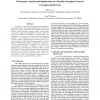Free Online Productivity Tools
i2Speak
i2Symbol
i2OCR
iTex2Img
iWeb2Print
iWeb2Shot
i2Type
iPdf2Split
iPdf2Merge
i2Bopomofo
i2Arabic
i2Style
i2Image
i2PDF
iLatex2Rtf
Sci2ools
IPPS
1997
IEEE
1997
IEEE
Performance Analysis and Optimization on a Parallel Atmospheric General Circulation Model Code
An analysis is presented of the primary factors influencing the performance of a parallel implementation of the UCLA atmospheric general circulation model (AGCM) on distributedmemory, massively parallel computer systems. Several modifications to the original parallel AGCM code aimed at improving its numerical efficiency, load-balance and single-node code performance are discussed. The impact of these optimization strategies on the performance on two of the state-of-the-art parallel computers, the Intel Paragon and Cray T3D, is presented and analyzed. It is found that implementation of a loadbalanced FFT algorithm results in a reduction in overall execution time of approximately 45% compared to the original convolution-based algorithm. Preliminary results of the application of a load-balancing scheme for the Physics part of the AGCM code suggest additional reductions in execution time of 15-20% can be achieved. Finally, several strategies for improving the single-node performance of...
| Added | 06 Aug 2010 |
| Updated | 06 Aug 2010 |
| Type | Conference |
| Year | 1997 |
| Where | IPPS |
| Authors | John Z. Lou, John D. Farrara |
Comments (0)

